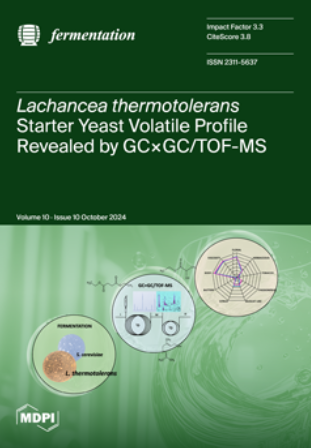Biomethane Potential in Anaerobic Biodegradation of Commercial Bioplastic Materials
IF 3.3
3区 农林科学
Q2 BIOTECHNOLOGY & APPLIED MICROBIOLOGY
引用次数: 1
Abstract
Bioplastics have emerged as a promising alternative to conventional plastics, marketed as environmentally friendly and sustainable materials. They provide a variety of methods for efficient waste management contributing to the goals of the circular economy. At their end-of-life stage, bioplastics can generate added value through aerobic and anaerobic biological treatments (composting or anaerobic digestion). In this study, biomethane potential (BMP) tests were carried out under mesophilic conditions on eight different catering biodegradable plastics available in the market and certified as being biodegradable under industrial composting conditions. Chemical analysis of the biodegradable plastics included elemental analysis, Fourier-transform infrared spectroscopy, and inductively coupled plasma–optical emission spectrometry. Key differences were observed in total solids (TS) and volatile solids (VS) contents between the studied biopolymer products. TS values ranged between 85.00 ± 0.26% (Product 8) and 99.16 ± 0.23% (Product 4), whereas VS content ranged between 64.57 ± 0.25 %wm (Product 6) and 99.14 ± 0.17 %wm (Product 4). Elemental analysis (elements C, H, N, S, and O) was used to estimate the theoretical methane production (ThBMP) of each product. The highest ThBMP (538.6 ± 8.7 NmL/gVS) was observed in Product 4 correlated with the highest C and H contents, while the lowest ThBMP (431.8 ± 6.1 NmL/gVS) was observed in Product 2. Significant differences were recorded between BMP values according to the chemical composition of the polymers. The average of BMP values ranged between 50.4 ± 2.1 NmL/gVS and 437.5 ± 1.0 NmL/gVS. Despite being characterized by the same composition (cellulose/cellulose derivatives and calcium carbonate), Products 2, 3, and 6 revealed significant differences in terms of TS, VS, ThBMP, and BMP. Furthermore, a significant statistical relationship (p < 0.001) was found between time (days) and BMP values of the eight products (R2 = 0.899–0.964) during the initial phase. The study confirmed that cellulose-based materials can convert efficiently under mesophilic conditions into methane, at a relatively short retention time; hence, they can be regarded as a promising material for co-digestion with feedstock in industrial anaerobic biogas plants. In contrast, biodegradation of polylactic acids (PLA) does not occur under mesophilic conditions, and hence, pre-treatment of the polymers is recommended. Moreover, PLA-containing products are highly affected by the presence of other components (e.g., polybutylene adipate terephthalate and cellulose/cellulose derivatives).生物甲烷在商用生物塑料材料厌氧生物降解中的潜力
生物塑料已成为传统塑料的一种很有前途的替代品,作为环保和可持续的材料进行营销。它们为有效的废物管理提供了多种方法,有助于实现循环经济的目标。在生命末期,生物塑料可以通过好氧和厌氧生物处理(堆肥或厌氧消化)产生附加值。在这项研究中,在中温条件下对市场上可买到的八种不同的餐饮用可生物降解塑料进行了生物甲烷潜能(BMP)测试,并证明在工业堆肥条件下是可生物降解的。可生物降解塑料的化学分析包括元素分析、傅立叶变换红外光谱法和电感耦合等离子体-光学发射光谱法。在所研究的生物聚合物产品之间,观察到总固体(TS)和挥发性固体(VS)含量的关键差异。TS值介于85.00±0.26%(产品8)和99.16±0.23%(产品4)之间,而VS含量介于64.57±0.25%wm(产品6)和99.14±0.17%wm(产物4)之间。元素分析(元素C、H、N、S和O)用于估计每种产品的理论甲烷产量(ThBMP)。在产品4中观察到最高的ThBMP(538.6±8.7 NmL/gVS)与最高的C和H含量相关,而在产品2中观察到最低的ThBMP,(431.8±6.1 NmL/gVS)。根据聚合物的化学组成,BMP值之间存在显著差异。BMP的平均值介于50.4±2.1 NmL/gVS和437.5±1.0 NmL/gVS之间。尽管以相同的组成(纤维素/纤维素衍生物和碳酸钙)为特征,但产品2、3和6在TS、VS、ThBMP和BMP方面显示出显著差异。此外,在初始阶段,8种产品的时间(天)和BMP值(R2=0.899-0.964)之间存在显著的统计关系(p<0.001)。研究证实,纤维素基材料可以在中温条件下以相对较短的停留时间有效地转化为甲烷;因此,它们可以被认为是一种很有前途的工业厌氧沼气厂与原料共消化的材料。相反,聚乳酸(PLA)的生物降解在中温条件下不会发生,因此建议对聚合物进行预处理。此外,含有PLA的产品受到其他组分(例如聚己二酸对苯二甲酸丁二醇酯和纤维素/纤维素衍生物)存在的高度影响。
本文章由计算机程序翻译,如有差异,请以英文原文为准。
求助全文
约1分钟内获得全文
求助全文
来源期刊

Fermentation-Basel
BIOTECHNOLOGY & APPLIED MICROBIOLOGY-
CiteScore
3.80
自引率
18.90%
发文量
594
审稿时长
7 weeks
期刊介绍:
Fermentation-Basel is an international open access journal published by MDPI, focusing on fermentation-related research, including new and emerging products, processes and technologies, such as biopharmaceuticals and biotech drugs. The journal enjoys a good reputation in the academic community and provides a high-impact forum for researchers in the field of bioengineering and applied microbiology.
 求助内容:
求助内容: 应助结果提醒方式:
应助结果提醒方式:


